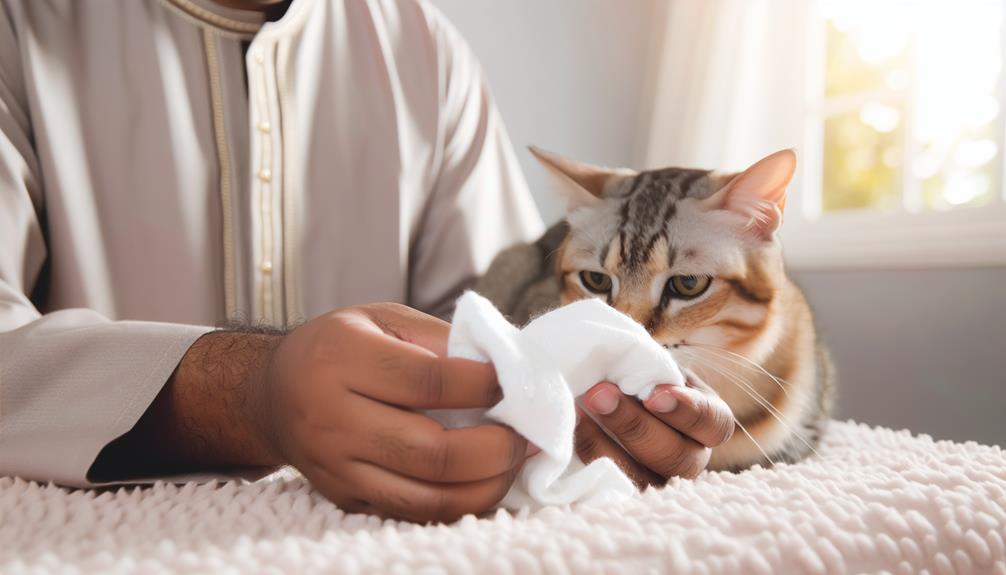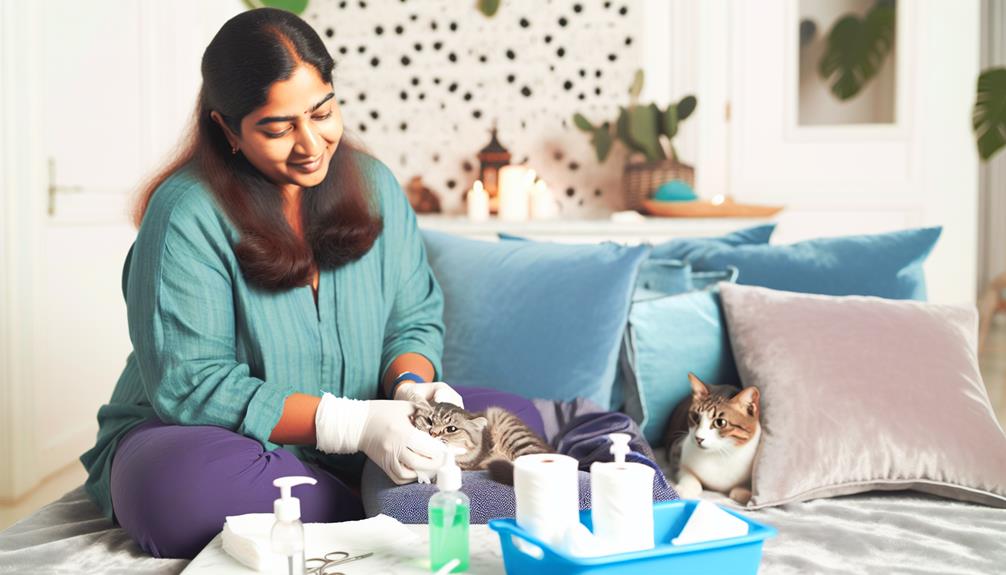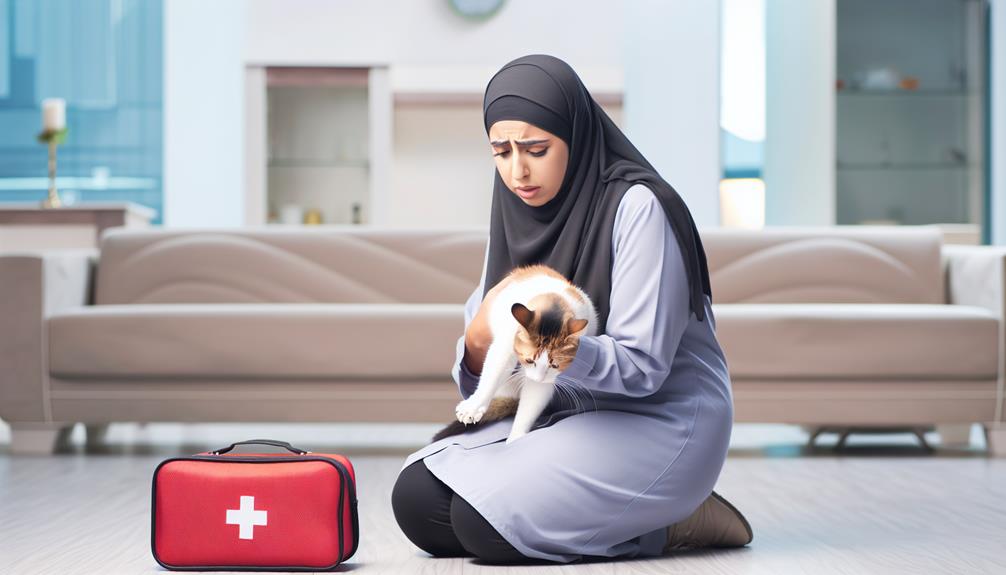You might not know that a cat's wound can get infected even if it looks minor at first. If you notice signs like increased redness, swelling, or a discharge that's not clear, it's time to take action. Start by immobilizing your cat and gently cleaning the wound with saline solution. Apply a sterile bandage and keep an eye on any changes in behavior, such as lethargy or a lack of appetite. If the symptoms don't improve or get worse, it's essential to consult your veterinarian. So, what's the next step in ensuring your furry friend's wound heals properly?
Recognizing Infection Symptoms
When your cat's wound appears to be healing poorly, it's important to recognize the symptoms of infection early. Early detection can greatly improve the prognosis and guide appropriate treatment. Various wound types, such as lacerations, punctures, or abrasions, are susceptible to infection due to differing infection causes and exposure levels.
First, observe the wound closely. Look for increased redness, swelling, or warmth around the wound site, which are common indicators of inflammation. Additionally, the presence of purulent discharge, which is a thick, yellow or green fluid, suggests bacterial colonization. It's important to differentiate this from normal wound exudate, which is generally clear or slightly yellow.
Behavioral changes in your cat can also signal an infection. Increased licking or biting at the wound, lethargy, and decreased appetite are all signs that your cat may be experiencing discomfort due to an infected wound. Cats are adept at hiding pain, so subtle changes in behavior are notable.
Monitor for systemic symptoms as well. Fever, which can be detected by a rectal thermometer reading above 102.5°F (39.2°C), indicates a more severe infection that may be spreading. Lymphadenopathy, or swollen lymph nodes, near the wound is another significant sign suggesting the immune system's active response to infection.
Understanding the infection causes, such as bacterial contamination from the environment or your cat's own mouth, is crucial. Bacteria like Staphylococcus and Streptococcus are common culprits. Puncture wounds, often from fights with other animals, have a higher risk of infection due to anaerobic bacteria introduced deep into the tissue.
Immediate Home Care Steps
Although recognizing infection symptoms is vital, immediate home care steps can mitigate complications and promote healing. When you suspect your cat's wound is infected, timely intervention is necessary to prevent further health issues. Start by evaluating the wound type, as different wounds require varied care approaches. Puncture wounds, lacerations, and abrasions each have distinct characteristics that dictate specific initial treatments.
First, limit your cat's movement to prevent exacerbation of the wound. Immobilizing your cat reduces the risk of further contamination and injury. Next, perform a preliminary cleaning with saline solution to gently remove debris and bacteria, but remember, detailed cleaning protocols will be discussed later.
Applying a bandage is a key step. Proper bandage application not only protects the wound from external contaminants but also helps to control any bleeding. Use sterile gauze and medical tape to secure the bandage, making sure it's snug but not too tight, as overly tight bandages can impede circulation.
Here are essential immediate home care steps:
- Immobilize your cat: Reducing movement minimizes further injury and contamination.
- Preliminary cleaning: Use saline solution to gently cleanse the wound surface.
- Bandage application: Secure a sterile bandage to protect the wound and manage bleeding.
- Monitor for complications: Keep a close watch for signs of worsening infection or other complications like swelling, redness, or increased discharge.
Implementing these immediate home care steps with precision can greatly enhance your cat's recovery process. Confirm that you follow these expert-guided measures to provide the best initial care for your feline companion's infected wound.
Cleaning the Wound Properly

After you've taken the immediate steps to stabilize your cat's condition, the next focus should be on cleaning the wound properly. Effective wound cleaning techniques are vital to prevent further infection and promote healing. First, make certain that you have all necessary supplies: sterile gauze, saline solution, antiseptic solution, and clean gloves.
Begin by gently restraining your cat to minimize movement during the cleaning process. This can be done using a towel or having a second person assist you. Wearing clean gloves, carefully trim any fur around the wound to provide a clear working area, and to prevent fur from contaminating the wound.
Next, use an appropriate cleaning solution such as sterile saline solution to irrigate the wound. Saline is preferred because it's isotonic, meaning it won't disrupt the cells' balance. Gently pour or spray the saline solution over the wound, allowing it to flush out debris and bacteria. Avoid using hydrogen peroxide or alcohol, as these can cause tissue damage and delay the healing process.
After thoroughly rinsing with saline, apply an antiseptic solution like chlorhexidine or povidone-iodine, diluted to the appropriate concentration (0.05% for chlorhexidine and 1% for povidone-iodine). Using sterile gauze, gently dab the antiseptic onto the wound, ensuring even coverage without vigorous scrubbing, which can cause further tissue damage.
Once cleaned, allow the wound to air dry briefly before covering it with a sterile bandage if necessary. Monitor the wound closely for signs of improvement or worsening. Proper wound cleaning techniques and the use of appropriate cleaning solutions are fundamental steps in managing your cat's infected wound at home.
When to Call the Vet
Persistent swelling, redness, or discharge from your cat's wound may signify an underlying issue that requires veterinary attention. Recognizing the signs of infection early can be vital for effective treatment and preventing complications.
Signs of infection to watch for include:
- Persistent swelling: If the area around the wound remains swollen or grows larger, it may indicate an infection or an abscess.
- Redness: Ongoing or spreading redness around the wound is a common sign of an inflammatory response to infection.
- Discharge: Pus or any unusual discharge from the wound, especially if it has an unpleasant odor, suggests bacterial contamination.
- Behavioral changes: If your cat seems lethargic, loses appetite, or shows signs of pain, these could all be indicators of a systemic infection.
When these signs are present, it is important to seek veterinary care promptly. Your vet may perform a thorough examination, take a sample of the discharge for culture, and recommend appropriate treatment options.
Treatment options often involve:
- Antibiotics: Your vet might prescribe oral or topical antibiotics to combat the infection effectively.
- Cleaning and debridement: In some cases, the wound may need to be professionally cleaned and dead tissue removed to promote healing.
- Drainage: For abscesses, your vet may need to drain the wound to remove accumulated pus.
- Pain management: Your cat may be given pain relievers to guarantee comfort during the healing process.
Ignoring these signs can lead to more severe issues, including systemic infections that are harder to treat. By monitoring your cat closely and acting swiftly, you can help facilitate a speedy recovery and prevent further complications.
Preventing Future Infections

Addressing an existing infection is just one part of the equation; making certain your cat doesn't experience recurrent wounds is equally important. By focusing on wound hygiene and dietary support, you can greatly reduce the risk of future infections.
Regular grooming is fundamental for maintaining wound hygiene. Brushing your cat helps to remove dirt and debris that can irritate the skin, potentially leading to wounds. In addition to grooming, routinely inspect your cat for any signs of injury or infection. Early detection allows for prompt intervention, minimizing the risk of complications.
Dietary support plays a pivotal role in your cat's overall health and resilience against infections. A balanced diet, rich in essential nutrients, boosts the immune system and accelerates wound healing. Omega-3 fatty acids, zinc, and vitamin E are particularly beneficial. Consult your veterinarian for dietary recommendations tailored to your cat's specific needs.
Implementing a clean and safe living environment is another critical measure. Make certain your cat's living area is free from sharp objects and hazards that could cause injury. Regularly clean bedding and litter boxes to reduce exposure to harmful bacteria.
Here's a quick reference table to help you implement these preventive measures:
| Preventive Measure | Description | Benefits |
|---|---|---|
| Regular Grooming | Brushing to remove debris and dirt | Promotes wound hygiene and early detection |
| Balanced Diet | Nutrient-rich food with omega-3, zinc, and vitamin E | Enhances immune function and wound healing |
| Safe Living Environment | Removing hazards and maintaining cleanliness | Reduces risk of injuries and bacterial exposure |
| Routine Health Checkups | Regular vet visits for thorough health assessments | Early detection and prevention of potential issues |
Conclusion
If you suspect your cat's wound is infected, acting quickly is essential. Recognize symptoms like increased redness and swelling. Clean the wound with saline, apply a sterile bandage, and monitor closely. Curiously, studies show that 25% of untreated cat wounds develop severe infections. If symptoms persist, contact your vet to prevent complications and guarantee proper healing. Your prompt and informed response can greatly improve your cat's recovery outcomes.
